1985 Austrian Grand Prix race report
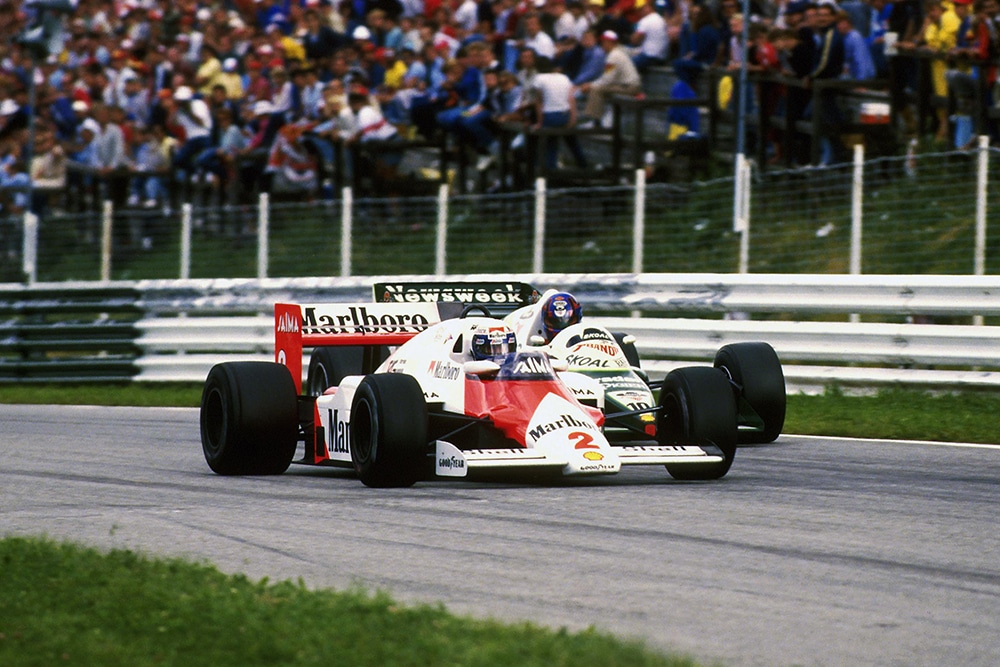
Alain Prost claimed his fourth win of the season to head the championship table for the first time
Motorsport Images
Not exciting
Österreichring, August 18th
Austria was enjoying some perfect summer weather when the Formula One circus assembled in the huge paddock at the Österreichring and everything was set fair for some spectacular high speed motoring up the hills and down the swoops of one of the better Grand Prix circuits. There is no way you can class the Österreichring as an Autodrome or Stadium; along with Francorchamps it is pure Grand Prix, not even Formula One.
In the pit lane there was a sadness at the Ioss of Manfred Winkelhock, killed in a sports car race in Canada the previous weekend and John Macdonald had been forced to do some quick regrouping within the RAM team. Philippe Alliot took over car number 9 and Kenny Acheson was brought in to drive car number 10. After Teo Fabi’s pole Position on Pirelli tyres at the German Grand Prix the Italian tyre company decided they could produce enough tyres for the Toleman team to run a second car, so the amiable Piercarlo Ghinzani was entered with the second TG185. With everyone present and correct it meant there were 27 drivers for practice and qualifying and as the rules limit the number of starters to 26 it meant that somebody was going to get left out. You did not need to know much about Formula One to know that it was going to be Martin Brundle with the lone 3-litre Cosworth-powered Tyrrell, no matter how well he drove, except that it only wanted a slight falter on the part of the tail end runners and Brundle would be in 26th place, for he was ready to drive the Tyrrell 012 just as hard as it would go.
The Brabham team had a brand new BT54 for Marc Surer and the FISA scrutineers objected to the cockpit controlled vane that could change the direction of the air flow inside the left-hand side pod, to alter the flow through the coolers. This device had been used in the German GP to vary the temperature messages being sent to the electronic engine management system, in the interests of fuel consumption, but now FISA had declared it to be a “movable aerodynamic device” and as such it was illegal, so was removed from all three cars. Renault had a brand new RE60B car as the team spare and in spite of being in the wilderness of technical progress they still found time to start the Friday morning test-session with a cine camera mounted on the nose of one of their cars, though they were not attempting any more direct television stunts with an extra car, as they had done in Germany. Lotus had decided that Senna’s drive-shaft joint failure in Germany had been caused by a new design of rear upright, so an even newer one was being tried.
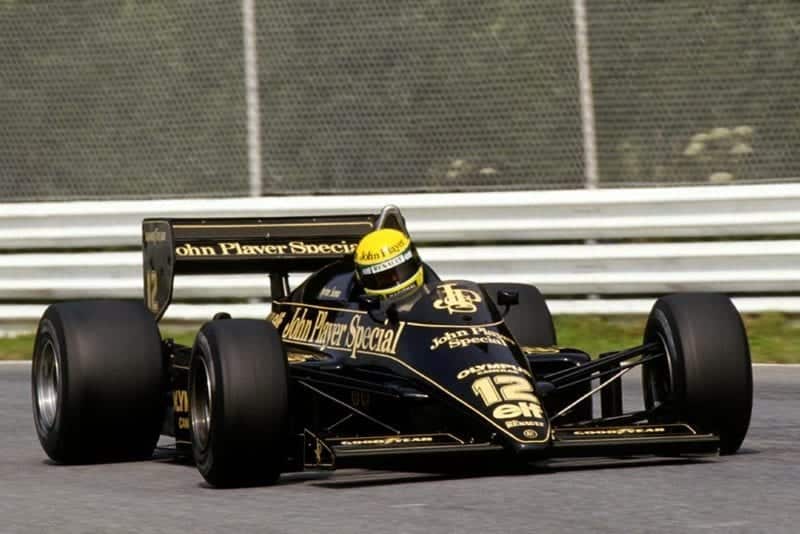
Ayrton Senna qualified a disappointing 14th for Lotus
Motorsport Images
Friday morning was superb as everyone juggled with tyres, aerodynamics, fore and aft loadings, brakes and engine power to arrive at a good compromise for race conditions and the maximum of everything for the afternoon qualifying session. As always happens trouble intervened to upset the best laid plans and it could be seen at both ends of the pit lane. At the top end Alboreto’s Ferrari blew up in a big way and caught fire briefly and at the bottom end Alliot’s RAM was all in bits having broken its gearbox. In between Tambay had abandoned his Renault out on the circuit and Senna’s Lotus had devoured one of the turbo-charger units on its Renault engine. In the Williams pits there seemed to be more Honda people than Williams people, and since the introduction of the completely revised V6 engine at mid-season the Honda element has grown dramatically and become a very powerful force on the scene.
Qualifying
It was still very hot as the qualifying hour of 1 pm approached and the spectators had been pouring in from all directions to fill the car parks and camp-sites, but when the track was announced open for qualifying there was a total reluctance to be first out, everyone hanging back for a slight drop in the temperature. After some minutes Brundle set the ball rolling in the TyrrellCosworth, his best time of 1 min 39.247 sec proving to be slowest time of the day! Other tail-enders came out and then there was a big cheer from the Italian element in the crowd as the first of the really fast runners appeared, in the form of Stefan Johansson in the works Ferrari number 28. Then the pace hotted up as Mansell, Senna, Rosberg, Fabi and Alboreto appeared to make their first qualifying runs, some on soft qualifying tyres that were barely good enough for one high-speed lap, others on soft race-tyres which would stand the pace for a lap or two. Alboreto was in the T-car as his own Ferrari was still being worked’ on following its morning disaster, and he didn’t complete a lap before the engine broke! Alain Prost timed his appearance perfectly, with a clear track ahead of him and made the most of it with a smooth and unruffled 1 min 25.490 sec to be in a class of his own.
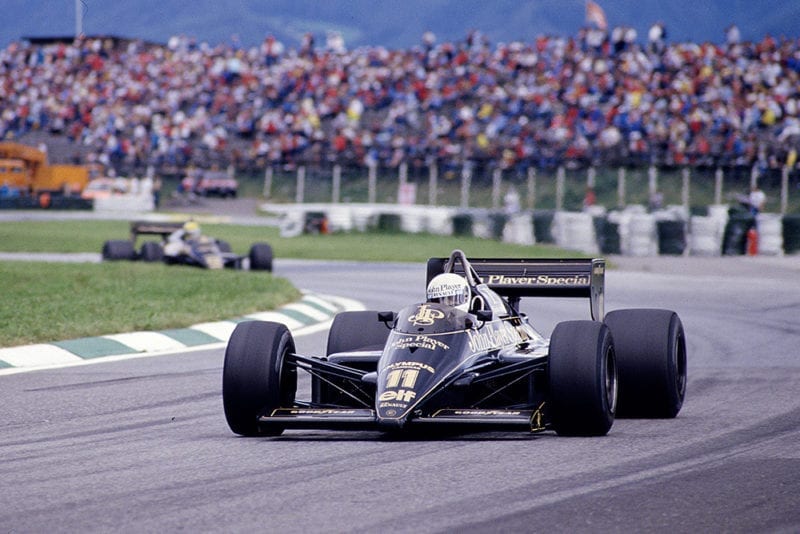
Elio de Angelis qualified 7th
Motorsport Images
Rosberg held second place for a long time, but then the wily Lauda slipped in a perfect lap to move into second place. Senna was not at all happy with the feel of his Lotus 97T and Team Lotus was beginning to wonder if it had made a mistake by not doing any prerace testing on the high-speed Austrian circuit. Warwick was getting nowhere with his Renault, the V6 engine suffering continual misfiring, and as the spare car was set up with a race engine in it, he was put into Tambay’s car, the Frenchman having qualified in eighth place. The driving styles of the two Renault drivers is very different, as are the detail characteristics of their cars, and Warwick found to Tambay’s cost that the car was very “nervous” under braking. On his fast lap the rear wheels locked under braking for the chicane at the top of the steep hill after the start and the Renault went into an enormous spin and bounced off the guard rails, wrecking the front suspension. Warwick was completely unhurt, but a little embarrassed at having to walk back and tell his team-mate he had crashed his car. There were similar problems in the Ferrari team, with a shortage of cars and Alboreto borrowed Johansson’s car to set a time, but at least he didn’t crash it.
Speeds were very high, with Prost averaging 250.2 kph (155.4 mph) on his pole position lap, with the Ferrari and Piquet’s Brabham clocking over 189 mph across the timing line and nudging 200 mph as they stormed up the steep hill to the chicane. On the top straight, which isn’t really straight, the faster cars were clocking over 200 mph on the approach to the daunting downhill Bosch Kurve. Poor Martin Brundle’s Cosworth-powered Tyrrell could only record 155 mph across the finish line and it lost speed when it hit the steep hill. However, although he was slowest he ended up in 25th place because Martini crashed the Minardi on his first lap and never recorded a time and Acheson only got in a single lap as the chequered flag came out, so he did not record a time. It had been a busy hour, with cars blowing up or crashing and Rosberg had a tense moment when his rear aerofoil collapsed internally and it all sagged down to the left, but when he stopped the outer skin pulled it all straight and it looked alright, except that it had no internal strength to withstand aerodynamic loads at high speed.
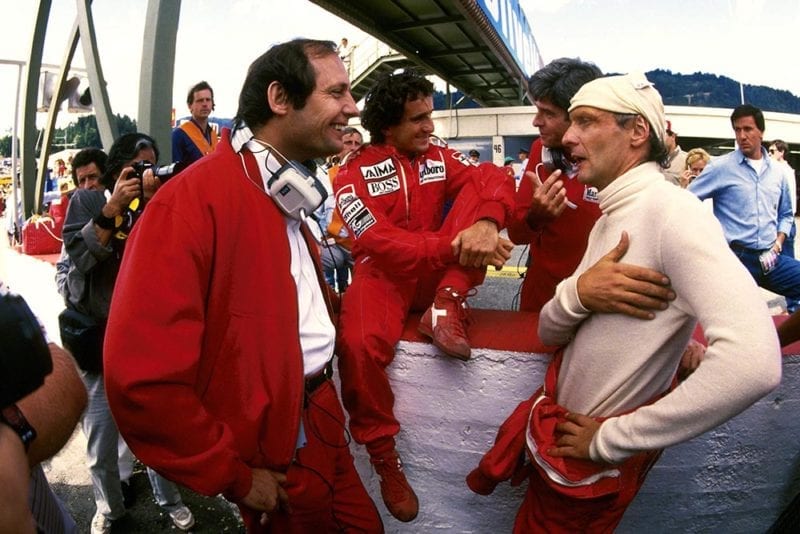
Niki Lauda chats with McLaren boss Ron Dennis and Prost
Motorsport Images
Saturday was still very warm and, before the test session began, Niki Lauda announced officially that he was retiring at the end of the year and leaving the McLaren team, and everyone was very appreciative of the straight forward way he did it this time, unlike the underhand way he had retired in 1979. There were a lot of drivers whose minds were on the forthcoming vacant seat in the McLaren team, rather than on what they were supposed to be doing! As if to press home his point about retiring while at the top Lauda recorded the fastest lap during the morning, but it was not really significant for everyone was busy trying things out and not bothering about ultimate lap times.
Morning testing ended at 11.30 am and qualifying began at 1 pm, and during that hour and a half ominous clouds appeared over the mountains to the south, so that when the track was announced as being open for qualifying there was a mad rush to get out and put in a quick lap before the rain came. Surprisingly, 15 drivers improved oh their Friday times, Martini and Acheson both recording a time which qualified them ahead of Brundle, even though the Tyrrell driver improved his own time by nearly two seconds, and upped his finish line speed to 161 mph. Up at the front Mansell jumped up into second place, but Senna did not get in a flying lap, his Renault engine going on the “blink” just as he got going. At ten minutes past one the first rain spots fell, and they wore big ones, a few minutes later the heavens opened and real 1985 poured down. Suddenly the whole scene was deserted as teams huddled in their garages and spectators left the open stands and looked for shelter. When the rain eased off, Eddie Cheever started up his Alfa Romeo and splashed off down the pit lane on heavily treaded rain tyres.
He was soon winging his lonely way round the deserted circuit, followed by an enormous cloud of spray. He went round and round, obviously enjoying himself, lapping in just over 1 min 50 sec and clocking 165 mph past the pits. One or two more drivers joined him but in reality qualifying was all over. Before the end of the afternoon the sun came out and dried things sufficiently for a supporting Formula 3000 race to be run, but as evening approached thunder and lightning came banging and flashing across the mountains and it rained and rained.
Race
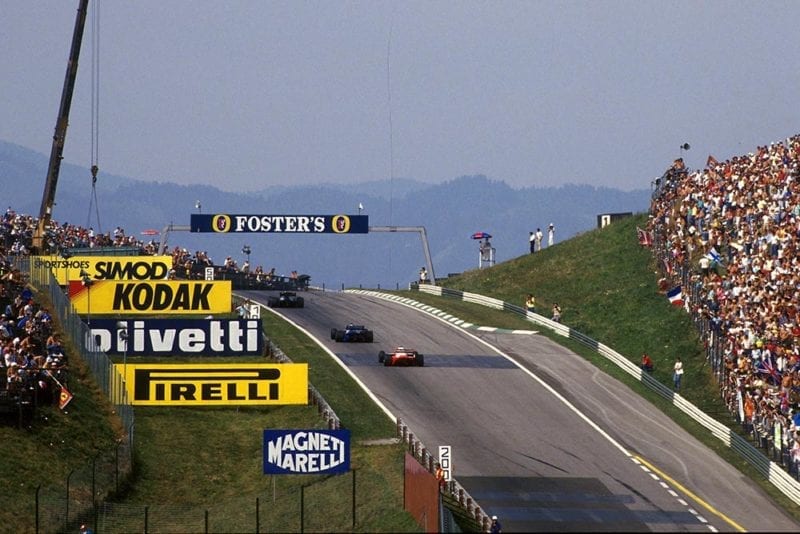
The race had to be restarted after a start-line shunt on lap 1
Motorsport Images
Early morning mist suddenly lifted and by 10 am there was blue sky and warm sunshine, but the whole Österreichring area was very wet and soggy, so much so that many official car parks had to be abandoned and cars re-directed onto the muddy foundations of a nearby motorway that was under construction, with fleets of mini buses to take people to strategic points. The morning warm-up saw some wet patches on parts of the circuit so everyone went pretty carefully, though Surer managed to spin off onto the wet grass without damage and Prost had an excursion into a run-off area when his throttles stuck open.
By 2 pm when the cars left the pit lane the sky was a mixture of white clouds and blue background. Ayrton Senna, from his lowly 14th place on the grid was a bit concerned at the closeness of the cars all round him and the narrowness of the track between the pit wall and the grandstands. As the 26 cars lined up on the dummy grid there was a panic over Prost’s car as it was thought that a driveshaft joint might be a bit suspect, and there was a move to put him into the T-car, but it did not materialise. Shortly before 2.30 pm Prost led the field round on the parade lap and as the cars lined up on the grid Fabi’s Hart engine was sounding very peculiar. When the green light came on the Toleman did not surge forward and could not have done so anyway as Mansell’s Honda engine “bogged down” as he snatched second gear and Rosberg nearly ran into him. There was a lot of dodging about in mid-field and much tyre banging and bumping and a right old jam-up from which Fabi’s Toleman, Alboreto’s Ferrari and Berger’s Arrows lay derelict after everyone had jostled their way through. As the leaders came round the Rindt Curve to finish the opening lap the start-line was a sea of waving yellow flags and among them the red flag to announce that the race was stopped. Fortunately no one had been hurt in the melee so it was just a matter of clearing the wreckage away and getting out spare cars to replace the damaged ones.
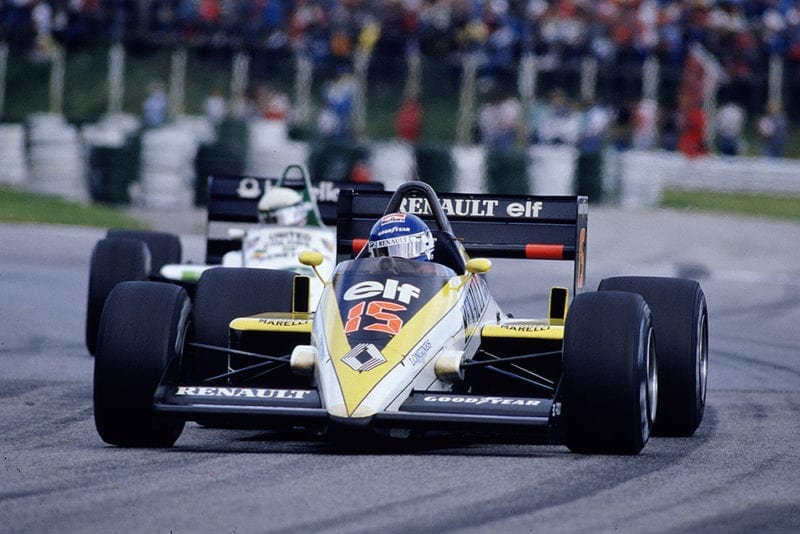
Patrick Tambay’s Renault engine gave out on lap 46
Motorsport Images
Prost took this opportunity to change to the spare McLaren and de Angelis took the spare Lotus as his own car had suffered a bent rear suspension member in the fracas. Ghinzani’s Toleman was found to have damaged its engine in the single lap, and with Fabi in the spare car, there was nothing to do but wheel it off the grid. It was 3.10 pm when they tried again and this time everyone got away all right, the race to be over 52 laps. Mansell made another hesitant start and Rosberg was by and after Prost, who had shot into the lead. Senna picked up four places in the space of the opening lap and was in behind Alboreto’s Ferrari, but Prost and Rosberg were running away from everyone. Lauda was comfortably in third place, ahead of Piguet, de Angelis, Mansell, Tambay, Fabi, Alboreto and Senna. The Williams-Honda challenge only lasted for three laps for, on the fourth, Rosberg dropped away and came free-wheeling into the pit lane. All the oil pressure had gone and for an engine turning at 11,000 rpm and pushing out 700 bhp that spells disaster.
As a race it was now all over for Prost was way ahead of Lauda and one thing the little Frenchman can be guaranteed to do is to cruise round at a comfortable pace without using too much fuel or straining the machinery, yet stay well ahead of any possible opposition. It’s a long time since we have seen McLaren-Porsche domination like this and the white and red cars had first and second places all sewn up. While there was no actual passing going on behind the two McLarens, third place was in the balance between Piquet’s Brabham-BMW, the Lotus-Renault of de Angelis and Mansell’s Williams-Honda, with Tambay, Fabi, Alboreto and Senna following.
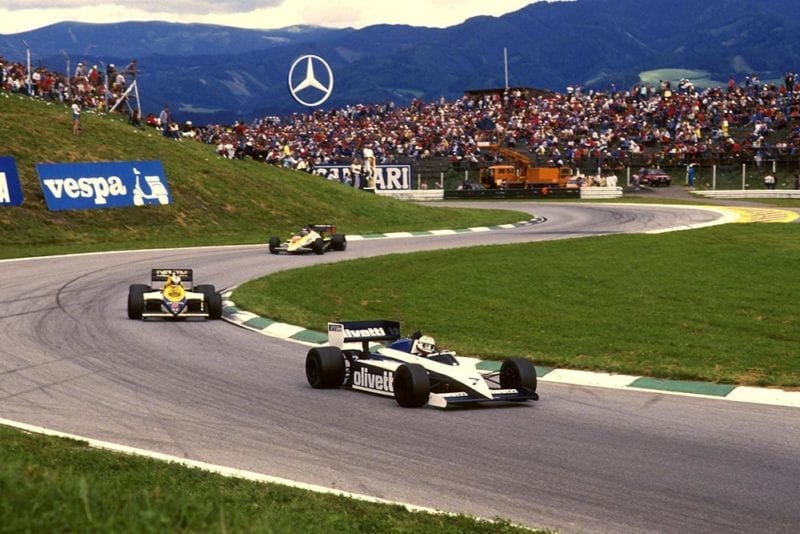
Brabham’s Nelson Piquet retired on lap 26 with exhaust trouble
Motorsport Images
Warwick was doing his best to keep Johansson at bay and the Ligiers of de Cesaris and Laffite were following. Down at the back Palmer actually had the Zakspeed ahead of the Alfa Romeo of Patrese, as well as Rothengatter, Martini, Acheson and Alliot, the two RAMs sounding as rough as the proverbial bear’s backside. At the end of lap 9 Tambay was seen heading for the pit lane, the Renault waving its right front wheel in the air as the car was sitting lopsided, running on a flat left rear tyre. No damage was done and a new set of Goodyears soon had him back into the race, but now well down the field.
The McLaren demonstration continued unabated, while others dropped by the wayside, Palmer with engine failure in the Zakspeed, de Cesaris in the father-andmother of crashes as he got his Ligier’s rear wheels on the grass and the car then rolled and bounced its way along to stop, luckily the right way-up and the young Italian stepped out unscathed. Fabi, disappeared into the pits with his engine running badly, Mansell went out when his Honda engine blew up and Piquet retired his Brabham with a broken exhaust losing him turbo pressure. As half distance approached Prost decided to ease his pace a bit, assuming that Lauda would ease up as well, but the wily “Rat” had other ideas and began to close up on the leader, so Prost opened up again! At half distance Prost was heading for the pits and a new set of Goodyears, and Lauda went by into the lead, but once back in the race on new tyres Prost soon began to eat up Lauda’s lead. With the numerous retirements Senna had now moved up into third place, having passed Alboreto and de Angelis, but it was a very poor and uncompetitive third place. A cloud of smoke saw Warwick coast over the hill after the pits with Renault failure, and de Angelis stopped for new tyres, as did Boutsen.
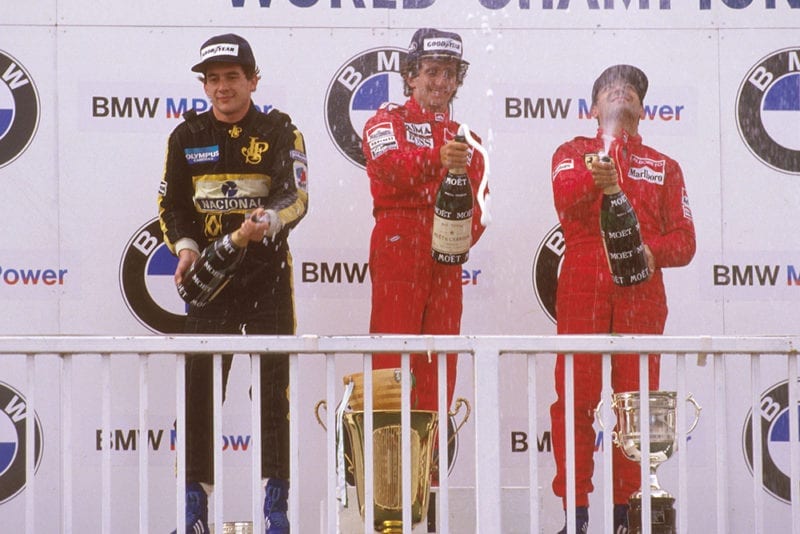
Prost does his grand prix duty, helped by Senna (left) and Alboreto
Motorsport Images
Prost was closing on Lauda pretty rapidly and would clearly be overtaking the World Champion, which wasn’t going to make him very popular with the Austrian crowd; he was already unpopular with the Italian crowd as he had led the two Ferraris from the start. Before the decision had to be made about passing Lauda, Porsche stepped in and Lauda’s engine suddenly cut out as he finished lap 40 and he coasted to a stop at the end of the pits, his race over; the trouble was given as “turbocharger” by his team but the way that the Porsche engineers were investigating it rather suggested an internal breakage. The small spark of interest that had flared briefly was now gone and Prost ticked off the remaining laps with clock-like precision, to unobtrusively win yet another Grand Prix. Senna came home in a rather uninspiring second place, at least thankful that neither Lotus nor Renault had let him down this time, and Alboreto and Johansson brought their Ferraris in behind the Lotus. In fifth place was de Angelis, on the same lap as the leader, and sixth was Marc Surer in a rather sick-sounding Brabham. Almost within sight of the end of the race Tambay’s Renault failed and blew oil over his rear tyres, putting him off onto the grass and out of the race. Rothengatter’s Osella had suffered engine trouble, but he manfully kept it running to the finish on fewer and fewer cylinders, and Bellofs TyrrellRenault ran out of fuel at the finish. D.S.J.
Results
Austrian Grand Prix – Formula One – 52 laps – Österreichring – 5.942 kilometres per lap – 308.984 kilometres – Sunny and cloudy
1st: Alain Prost (McLaren MP4/2B-3) (T) 1 hr 20 min 12.583 sec. – 231.132 kph
2nd: Ayrton Senna (Lotus 97T/4) 1 hr 20 min 42.85 sec.
3rd: Michele Alboreto (Ferrari 156/85-080) (T) 1 hr 20 min 46.939 sec.
4th: Stefan Johansson (Ferrari 156/85-079) 1 hr 20 min 51.656 sec.
5th: Elio de Angelis (Lotus 97T/2) (T) 1 hr 21 min 34.675 sec.
6th: Marc Surer (Brabham BT54/8) 1 lap behind
Fastest lap: Alain Prost (McLaren MP4/2B-3) (T) on lap 39 in 1 min 29.241 sec. – 239.701 kph
